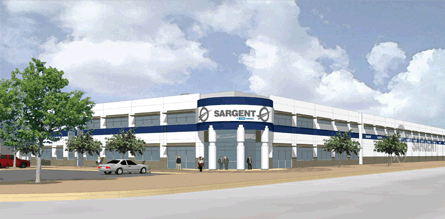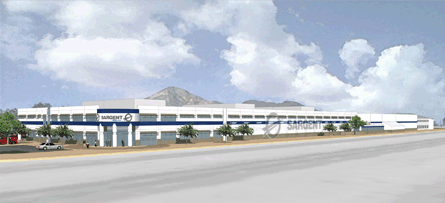Tucson-based Sargent Aerospace & Defense has come to Farnborough with a message for all the integrators and manufacturers keen to consolidate the traditional tangled web of supplier arrangements accompanying a major aerospace project: we are here to help.
By consolidating and assimilating its own various legacy brands into two distinct channels - OEM and aftermarket business units - Sargent, a provider of hydraulic and pneumatic components, bearings, seals and joints for forward-fit applications and maintenance, repair and overhaul services for the aftermarket, hopes to create a comprehensive new brand that will allow it to easily capture a larger market share for any given programme.
"When you look at the systems like a landing gear on an aircraft, it uses all of our products," says Scott Still, Sargent Aerospace & Defense president. "When we have approached OEMs in the past, we didn't get that leverage. People looked at us like a bearing company rather than a major components provider." A bonus for OEMs is a reduction in their supply chain numbers.
 |
|---|
© Sargent Aerospace |
Interestingly enough, despite the disassociated names, Sargent would find that after gaining entry on a programme its content increasing in leaps and bounds. "It starts with one application, then it goes to 10-15," says Still. "We see that happening on most major programmes we're on, including the Boeing 787, Airbus A350 and Lockheed Martin F-35."
Sargent's OEM capabilities include the design and manufacture of hydraulic and pneumatic components, Kahr bearings, Airtomic rings, seals and alignment joints, Sonic fasteners and other products made in its facilities in the USA, Canada and Mexico.
The year-long recasting of the company, which aims to bypass the past ad hoc initiation onto programmes, also includes $18 million in infrastructure investments that should provide a fairly rapid payback in "green". An expansion at Sargent's Marana (Tucson), Arizona manufacturing plant, to be completed in March, will allow the company to begin using high velocity oxy-fuel (HVOF) spray technology to plate 300 of its parts, replacing the legacy chrome plating process with a more environmentally friendly substitute that also performs better. HVOF will also be used at Sargent's Torrance, California site.
Sargent's aftermarket business has facilities in Miami and Franklin, Indiana, each certificated by US, European and Chinese aviation authorities. The company offers component repair services, inventory and asset management solutions and pooling solutions for rotables and line-replaceable units.
Sargent in May announced a $1 million contract award from Texas Aero Engine Services for which it will overhaul more than 60 part types (tubes, ducts and manifolds) used on the Rolls-Royce RB211-535 engine at its Indiana facility.
 |
|---|
© Sargent Aerospace |
To better serve the forward-fit market, Sargent's Marana facility will nearly double in size, expanding from 7,430m² (80,000ft²) to 13,935m², room that will also make way for expanded product development capabilities, boosting the 750-employee company's revenues from around $200 million a year to an expected $250 million a year over the next three years.
A larger and consistent amount of the revenue - 5% - will also now be dedicated to research and development, says Still.
"We'll have a state-of-the-art R&D facility here in the new building," he says. "We're going to take our products to the next level - bearings, hydraulics, electromagnetic actuation and bolt technology."
One example is a new bearing liner under development that will add two times more life to helicopter main and tail rotor bearings. Sargent previously built the bearings through its company, Kahr Bearing. "Sand gets in the liner [of the bearing] and takes the life out," says Rich McManus, vice-president and general manager of Sargent's new OEM group. "Sikorsky is looking to retrofit and get the liner to last longer. We're 10-18 months away from having it."
Helping to engineer the new products for the commercial market is Sargent's ability to have a nearly 24h presence using its office in Bangalore, India, where 15-20% of the engineering work is completed, says McManus. "There's a cost benefit, but its also the case that they're half a day ahead, so we have a good compromise in working the other side of the clock."
Still and McManus expect the hustle and bustle of the commercial side of the market to come bounding back by mid-2011, in large part due to the convergence of builds for the Airbus A350, Boeing 737 and 787.
"The key is to have [our expansion] done by first-quarter 2011," says Still. "We feel the activity will go back up by the second or third quarter to suppliers," he says, adding that the 787 will have a "large content of HVOF products on it" for which Boeing has "few" approved suppliers. "If we install HVOF in Marana, we'll have in-house capacity to handle the products. I think a lot of suppliers on contract with Boeing will fall down when the rate picks up - we want to be there to capture that market."
McManus says: "Over time, they're going to phase out chrome plating. The percentage will grow with each passing year. Right now it's not an issue with demand being lower, but the latter half of 2011 or 2012, it will be. That's why you have to build up the capability now. It takes a long time to get the process approved by Tier 1 suppliers like Airbus and Boeing."
Along with the branding, Sargent's proactive strategies are meant to put the company in a new league going forward. "Sargent is out there investing in proactive solutions instead of waiting for our customers to say they have a problem," says Still. "We have product engineers and salespeople out there working with engineering departments and we hear what's going on."
Source: Flight Daily News























